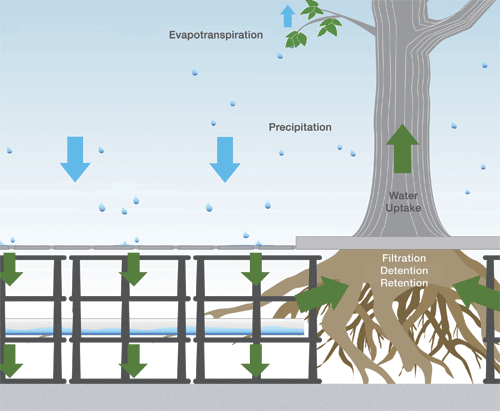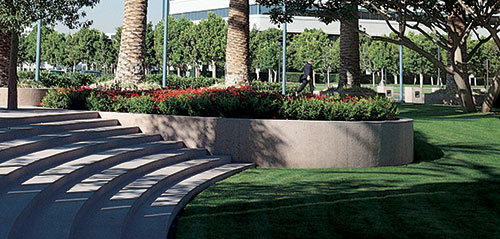Design Options for Greening Urban Environments
Expanding Plantable and Structural Soil Areas
However, structural soils—which are 80 percent rock and only 20 percent soil—in and of themselves are not sufficient in sustaining urban trees. At the 2011 Greenbuild conference, James Urban, FASLA, a contributor to the Cornell University study stated, “structural soils, which combine broken up rock and soil, have issues so urban tree planters came up with a new idea: suspended pavements.” Suspended pavements are constructed with either custom concrete systems or modular products like underground bioretention cells. Modular underground bioretention cells support the pavement while allowing plantable soil as well as underground irrigation systems to be installed below pavement. These cells contain the soil volume that nurtures trees and also slows and treats water before it is piped out. Leda Marritz, ISA-certified arborist for DeepRoot Green Infrastructure, states that modular underground bioretention cells may be used in urban environments such as streets, plazas, parking lots, green roofs, and more in order to expand urban tree plantings and manage stormwater on-site. (See case studies.)
 |
This diagram shows how a combination of structural soils, modular underground bioretention cells, and pervious flexible pavements improves the hydrolic cycle in urban areas, allowing stormwater to penetrate to planting areas below the pavement surface. Image courtesy of DeepRoot Green Infrastructure |
Reducing Urban Heat Islands and Stormwater Runoff
Paved urban environments present challenges with the management of stormwater and the excessive heat that emanates from these pavements. Urban pavements are traditionally non-pervious rigid materials. Flexible pavements are defined by AASHTO (American Association of State, Highway and Transportation Officials) as being one of four standard pavement surfaces. By AASHTO definition: “Flexible pavements in general consist of an asphalt-bound surface course or layer on top of unbound base and sub base granular layers over the subgrade soil. In some cases, the sub base and/or base layers may be absent (e.g., full-depth asphalt pavements); while in others the base and/or sub base layers may be stabilized using cementitious or bituminous admixtures. Drainage layers may also be provided to remove water quickly from the pavement structure.”
Although newer porous asphalt and concrete pavements are by design sufficiently permeable so that water can penetrate through, their inherent density and their subsurface design and compaction requirements, which provide a suitable surface for vehicular traffic, do not allow for the installation of structural soils underneath.
 |
The Koll Center in Irvine, California provides 6,000 square feet of grass pervious surface as a fire lane. Photo courtesy of Invisible Structures, Inc. |
Pervious Flexible Pavements
A pervious flexible paving system can provide another design solution in addition to suspended pavements for enhancing green space and transitioning from grey to green infrastructure. Pervious flexible paving systems can utilize either sand with seed/sod/groundcovers or gravel as filler materials. Both options provide benefits toward filtering and mitigating stormwater runoff and enhancing site ecology. Unlike standard gravel pavement surfaces, a gravel pervious flexible pavement system has added stability and prevents gravel migration as the gravel is contained by the grid paver system. It is dust free, easy to install, and very low maintenance.
Dustin Glist, media and information director for Invisible Structures, Inc., cites the following benefits of pervious flexible paving systems:
- Reduced site disturbance
- Enhanced stormwater management
- Reduced heat island effect
- Reduced water use through water efficient landscaping
- Erosion and sediment control
- Enhanced safety as a result of emergency access to tight urban areas
- Enhanced urban green space
The primary applications for grass/lawn pervious flexible pavements include residential drives and parking areas, pedestrian traffic zones, utility access areas, fire/emergency access areas, and parking lots. Some examples of this include the parking lot at the West Farms Mall in West Hartford, Connecticut; the parking lot at Reliant Stadium, Houston, Texas; road shoulder reinforcement in Calgary, Alberta, Canada; and fire/emergency access lanes at the Koll Center in Irvine, California.
The Koll Center used 6,000 square feet of grass pervious flexible pavement system to create a porous fire lane around the building. The grass pervious flexible pavement system is located on the south end of the building and within a parking lot. Koll Center is a complex of buildings centered around a beautifully designed outdoor fountain and pedestrian mall.









